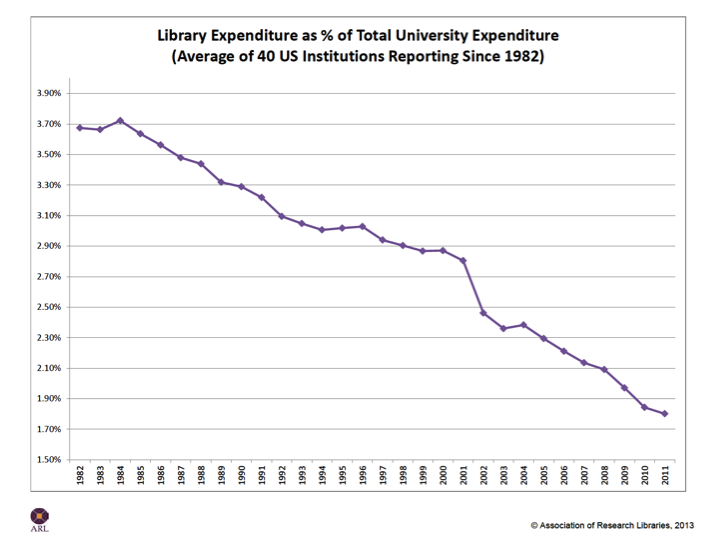As a percentage of overall university expenditures, libraries have been steadily losing ground. This is the main message of an updated graphic produced by the Association of Research Libraries (ARL).

Based on reports from 40 research libraries, the percentage of university funds spent on libraries has shrunk by over one-half in the past three decades, from a high of 3.7% in 1984 to just 1.8% in 2011. The downward trend is applicable to both public and private universities in the United States as well as institutions in Canada.
The simplest explanation to describe this trend is that the library has lost its coveted position as the intellectual hub of the university; that administrators don’t think of the library anymore — after all, information that arrives on one’s desktop must be free; and that students value the library more as a quiet place to nap between classes than as a scholarly resource. While these factors may be in play, I don’t believe they explain the trend.
The decline in library appropriation of total expenditures begins in the early 1980s. If you can remember that far back, you’ll recall that the electronic journal was not yet invented, that most research libraries relied on card catalogs, and that departmental libraries were alive and well. The microcomputer would not make its debut into libraries until the mid-to-late 1980s, and its use was limited almost exclusively to spreadsheets and text documents. The Internet, while in existence, was relegated to mainframe computers and dumb terminals. Pop music was in, but pop mail was just being invented. Students and researchers consulted print journals and used print indexes for the most part. If you were lucky, you could ask a librarian to conduct a DIALOG search or perhaps wait until literature indexes showed up on CDs, which were often locked up in a cabinet and required asking your librarian for the key.
The transformation that microcomputers, the graphical Internet browser, and finally, e-journals brought to the library created some pretty exhilarating times, and the library was leading the way for many of the changes that would begin to challenge its function (or more appropriately — functions) within the university. After ripping out carpets that reeked of stale cigarettes, many reading rooms were renovated into microcomputer classrooms as librarians became software and Internet instructors. Money was flowing into libraries to install electronic catalogs, or, if they had them already, to integrate them into a more modern library management system. Before the network was fast enough to deliver electronic journals, libraries provided them from dedicated computers, which were perched beside racks upon racks of journal CDs.
Somehow it’s hard to believe that during this time of great transition that the library was out of the minds of central administrators. It wasn’t, and we should avoid the temptation to interpret past trends with recent experiences.
I believe that ARL’s graph of library expenditure decline tells a mixed story of success and failure — success on the part of the library to live within its means, and failure for librarians to get a larger slice of a growing pie. As for the growing pie, it may indicate that universities have failed miserably to keep their own spending under control.
In his book, Tuition Rising: Why College Costs So Much (Harvard Univ Press, 2000), Cornell economist, Ronald G. Ehrenberg describes that multiple constituencies, operating largely independently from central budgeting authority, make it exceedingly difficult to control costs on campus. He illustrates how prestigious universities use scholarship funds to lure top-scoring students to campus whether or not they are in need of financial assistance; how universities give budget priority to the sciences and engineering over the social sciences and humanities; and how rising faculty salaries, incentives to lure top scholars, and the absence of mandatory retirement policies contribute to the rising costs of the academy. Moreover, as Malcolm Gladwell wrote in the New Yorker, an obsession with one’s rank in the U.S. News & World Report can create a very expensive higher education system that is not always focused on student learning.
Compare ARL expenditures with university spending, and the trend doesn’t look so grim. While library material costs have increased at a faster rate than the consumer price index (CPI), they look tame compared to the skyrocketing expenses going on elsewhere on campus. Part of this ability to control costs rests on the fact that librarians have much more flexibility in controlling expenses than most other departments on campus. It is much easier to cancel a serial than it is to layoff a tenured faculty member or the coach of the football team.
Let’s fast-forward from the early 1980s to the present and look at other efficiencies and cost controls that the library has been able to implement:
- Consolidation of libraries and physical space
- Bundled and consortial purchasing
- Ceasing print journal subscriptions
- Sharing and outsourcing of cataloging, reference, and digitization services
- Employing students to do the work of staff
- Staff reductions resulting from all of the above
Whether or not you agree with these explanations, the last 10 years have witnessed massive centralization of the university library with the goal of increasing efficiency while minimizing duplicate work. I am not suggesting that I agree with this approach or that it necessarily translates into equal or better services for patrons — in my experience, it hasn’t — but this has been the preferred path of university librarians.
In the mid-2000s, I brought an earlier version of the ARL graphic to a library collection development meeting dealing with one of a succession of budget shortfalls. When I presented the data that the library was being shortchanged by central administration, a senior librarian got red in the face, pointed his finger at me in an accusatory way and exclaimed, “That is Elsevier’s argument!” After regaining composure, I responded, “Yes it is, but that doesn’t make it wrong.” Either we we were going to fight for a fair share of the pie, or accept our fate and cut. I don’t have to tell you what path we (and most ARL libraries) took.
So what does the ARL graphic tell us? From a purely descriptive standpoint, the library has been getting less of the central pie for the last three decades. Depending on your perspective, this has been a great failure, a great success, or more realistically, some of each.
Editor’s Note: This post originally ran on February 12, 2012. It has been edited and updated with current statistics.
Discussion
5 Thoughts on "Libraries Receive Shrinking Share of University Expenditures"
This is an interesting piece of data, but it tells only a small part of the story. As Phil points out, the costs of a college education are increasing rapidly and I assume that the university expenditures as a whole are increasing well above inflation. I’d like to see that information and then compare library expenditures. I wonder if it wouldn’t show that while library expenditures as a percent of budget are declining, but that in real dollars expenditures are behaving differently. In fact without that information, this data point isn’t all that useful.
Bill, further down in the post, there is a link that breaks down library expenditures and compares them to the CPI (in my mind, not a great comparison index):
http://www.arl.org/storage/documents/expenditure-trends.pdf
If you want to perform your own calculations, ARL also provides a “machine readable” spreadsheet with materials expenditures:
http://www.arlstatistics.org/about/series/eg
As for an index that tracks the cost of higher education, the Higher Education Price Index (HEPI) may be a good start:
https://www.commonfund.org/commonfundinstitute/hepi/pages/default.aspx
The news here is that ARL seems to complain about budgets — rather than publishers!
The problem did not start in the 1980s. After all, the National Enquiry into Scholarly Communication published its recommendations in 1979, after a long, painful period of soul-searching. Looking at a similar group of universities from 1960 to 1995, I observed library spending flattened around 1970 while journal articles (output) continued to track upward along side economic inputs (Albert Henderson, “Information science and information policy,” ASIST 50:366-379, 1999). In sharp contrast, during the 1960s, decade of the Space Race and political focus on scientific information, library spending kept pace with economic inputs to academic R&D.
Indeed many/most (?) universities have been rapidly expanding, not only their programs and students but also: construction & renovation, campus residences, administrative personnel, student aid, launching overseas campuses. While I agree that libraries are *not* getting sufficient funds to provide for their campuses the services that these schools need and deserve, it seems to me that not all expansion is library related and that library budgets do not necessarily need to grow at the same rate as university budgets. Figuring out what part of university growth requires library support is, of course, a challenge.



